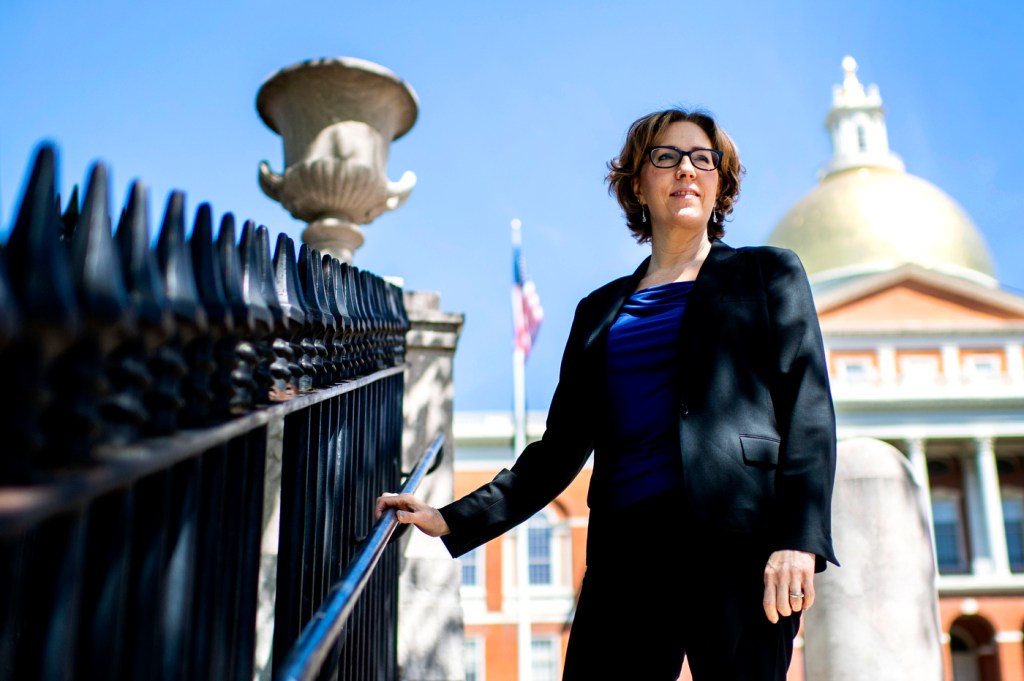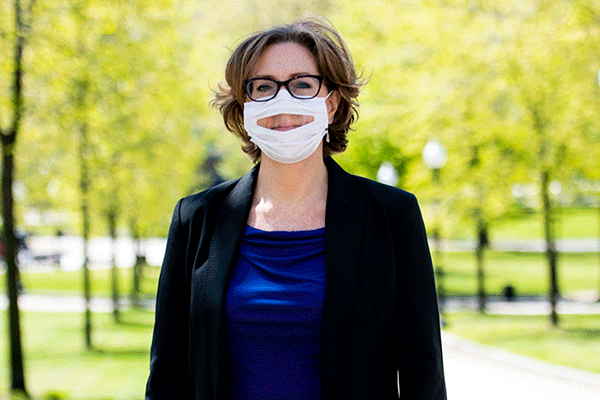New challenges–and opportunities–for American Sign Language users during COVID-19

When Lori Whynot is interpreting Massachusetts Gov. Charlie Baker’s COVID-19 press conferences, the information she’s relaying can be a matter of life and death. It’s crucial that the message be presented as clearly as possible.
And certain public health protocols enacted recently to help reduce the spread of the coronavirus that causes COVID-19—particularly the guidelines to wear masks in public—create a challenge for those using American Sign Language.
Wearing a mask while signing, says Whynot, who is the director of Northeastern University’s American Sign Language Program, “is like listening to a muffled message.”
That’s because “movements around the mouth—the puffing of cheeks, or the pursing of lips, or a sort of grimacing, showing of teeth” are used to modify certain verbs and nouns, she says.


In spoken English, how does one distinguish between “blue” and the kind of electric, neon blue of the sky on a clear, bright day? Adjectives and adverbs. One knows that “very bright blue” is more intense than “blue” because of the two little qualifiers before it: The adverb “very” ratchets up the adjective “bright” to illustrate the difference between the two.
How does one make this distinction in American Sign Language? The concept is the same—adjectives and adverbs—but the execution is different.
The sign for “blue” resembles the hand shape for the letter “B” in the ASL alphabet (a sort of “scout’s honor” gesture with the thumb across the palm and all four fingers upright) that one twists back and forth with a flick of the forearm.
To change regular “blue” into “very bright blue,” one modifies the hand sign with a certain pursing of the lips and squinting of the eyes, Whynot says. In American Sign Language, the parts of speech that qualify information—the language of adverbs and adjectives—are often conveyed through facial expressions.
“People think of American Sign Language as a very expressive language because they see all these different facial expressions,” Whynot says, “but it’s more than just emotional information; there’s linguistic information, too.”
And, like most languages, American Sign Language has a formal usage as well as a conversational, or atypical, usage, Whynot says.
The governor’s briefings are typically interpreted by a two-person team, Whynot says. A hearing person stands in the audience and translates what Baker says into sign language for a second person standing next to the podium, who interprets the signed translation into colloquial sign language, she says.
Whynot, who is hearing, has been working lately with Rupert Dubler, who has been deaf since birth and is a native American Sign Language user. Whynot signs to Dubler from the audience, and Dubler, standing six feet from the governor’s podium, “refines the message and makes the high-stakes information accessible to Deaf viewers who may not be bilingual and understand English captioning,” Whynot says.
(According to the National Association of the Deaf, deaf, written with a lowercase ‘d’ describes the audiological condition of not hearing, whereas Deaf, with a capital ‘D’ refers to a group of people who share a common language—American Sign Language—and culture.)
And not everyone who is deaf has access to American Sign Language or English from a young age, Whynot says. Lack of early exposure to ASL and to bilingual education (ASL and English) can “lead to atypical language use and reduced bilingual skills in deaf people,” Whynot says.
Working as a team of two gives interpreters an opportunity to make the message as clear and culturally accessible as possible for diverse deaf viewers relying on it, as well as those who may utilize such atypical language, Whynot says. It’s a chance to combine split-second interpreting with thoughtful translation constructed by a team.
“The work we do as interpreters—providing important health information particularly in this pandemic—is incredibly important,” Whynot says. “And having a native user deliver that information through a team of interpreters is a very effective way of doing it.”

Northeastern’s bachelor degree program, in which students are trained to become American Sign Language-English interpreters, is one of only 15 certified by the Commission on Collegiate Interpreter Education, an organization designed to standardize such programs.
Additionally, the university’s American Sign Language Program houses the Center for Atypical Language Interpretation, a program funded by a federal Department of Education grant to train interpreters in the type of atypical language that a person deprived of early sign language acquisition may adopt.
Whynot and Dubler are among a team of certified interpreters that serves the commonwealth, though Whynot’s interpreting experience has taken her all over the world.
Whynot has been a full-time interpreter for 30 years, and has traveled coast to coast in the U.S. to lend her interpreting services. From 2006 to 2010, she lived in San Diego, California, and served on the San Diego County Registry of Interpreters for the Deaf. In 2011, her work brought her to Australia, where, four years later, she earned her PhD in linguistics at Macquarie University in Sydney.
During those four years, she also led a committee of the Australian Sign Language Interpreters’ Association on Deaf interpreter issues and worked with the National Authority on the Accreditation of Interpreters and Translators to establish the official recognition and qualification of Deaf interpreters in Australia.
Now she’s back in Massachusetts, at the helm of Northeastern’s American Sign Language program on the Boston campus, and doing freelance interpretation as well.
Whynot says she views the work as a way to provide an essential civic service.
“This work, for me, is a conscious decision to do social justice work—the work we do impacts social inequalities,” she says. And she has no intention of stopping any time soon.
“I just love it, I think I’m going to continue interpreting until I can’t do it anymore.”
For media inquiries, please contact Shannon Nargi at s.nargi@northeastern.edu or 617-373-5718.





